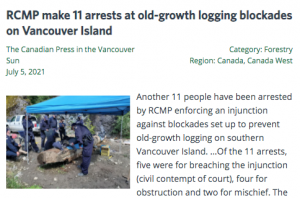
“I rented a cottage for a month in the wilds of Nova Scotia, just south of Kejimkujik Park… it seemed that everywhere I went I witnessed extreme devastation to our land…clear cutting everywhere” JFS, Aug 22, 2020 View Post)
Nova Scotia’s forests are amongst the most, if they are not the most, intensively harvested forests in Canada, currently and historically. And 65% occur on some of the poorest soils in North America
Forestry issues tend to be local; we react to what we see in the forests around us. This is especially true in NS which is 75% forested and few areas are very far from our towns and villages and many roads.
Widespread concerns about clearcutting in Nova Scotia have now led to two reviews (the Natural Resources Strategy of 2010, and the Independent (Lahey) Review of 2018), both recommending major reductions in clearcutting. In round one, it was to happen on both public and private lands; in round two, only on public lands but we have yet to see even that happen in practice. And even when the Lahey recommendations are finally implemented, clearcutting won’t stop on Crown lands, but rather it will be be restricted to High Production Forestry sites which will be situated on the most productive forest lands. Even so, Big Forestry is demanding and getting lots of inducements to cooperate, e.g., as illustrated by the latest announcement from the Premier’s Office/Lands and Forestry.
A lot has changed in the public consciousness since Prof. Lahey handed in his report on Aug 21, 2018. The immediacy of climate change has heightened concerns globally and locally about forest carbon sequestration, and we now talk about the dual and linked crises of climate change and biodiversity loss. Biodiversity loss was a concern addressed by Prof. Lahey but the role of forest carbon sequestration in climate change mitigation was barely mentioned.

Highlighted in the latest issue (July 5, 2021) of Treefrog Forestry News
The rekindling of concerns about clearcutting and loss of Old Growth in B.C., which many of us thought were over following the Clayoquot Sound protests in the 1990s, have reminded us that Nova Scotia is not the only jurisdiction in Canada where views of forestry are highly polarized. The stories about the struggles over forestry in B.C. that I read almost daily in Treefrog Forestry News involve the same plot, script and characters that have played out in NS; only the actors and the staging differ.
Government and some private Nova Scotians have looked to Europe, and to Sweden and Finland in particular, for guidance on how to practice forestry that is both profitable and socially acceptable. But even there, apparently, the same polarization of perspectives is at play.

Swedish article/English Google Translation
A leaked draft for a new EU forest strategy argues for some of the same changes in forestry practices that have been recommended for Nova Scotia in 2010 and 2018, but European forest owners and managers are not liking it and are demanding that the whole strategy be re-written.
For a summary of what the draft is about, view Future forests – if the European commission decides, an editorial by Per Johsson for Forestry.com (July 5, 2021). Here’s my Cole’s Notes version:
“A draft of the EU commission’s upcoming forest strategy about future forests has leaked. The Swedish daily tabloid “Dagens Nyheter”, DN, made the forest community in Sweden aware of this. It´s a draft for a strategy for forests within the EU, but with a hope that it should spread globally…the EU commission think that the forest industry must adapt to the forest, not as today when the forest is adapted to the industry…Building with wood is highly recommended…Bioenergy directly from the forest is not recommendable according to the draft. It´s ok only if byproducts from the sawmilling industry is used, such as sawdust…the EU commission think that clear-cuts let out too much carbon dioxide…It´s suggested that clear-cuts should be forbidden…a total stop of forestry activities during the breeding season for birds is suggested. Also, heavy forest machinery, that could cause soil compaction, should be avoided in the future forests… forest owners should be paid for the carbon storage”
For the Forest Owners’ and Managers’ perspective on it, view a June 30, 2021 Press Release from EUSTAFOR and others:
For the European forest owners and managers, the European Commission should purely rewrite the draft EU Forest Strategy!…The whole forestry community hopes that the Commission will seriously consider the concerns of forest owners and managers, engages with them to frame a policy that builds on their expertise and maintains their high motivation. No endorsement by those who take care of our forests would result in a failure of the implementation of the strategy.
Sound familiar? I guess we (NS) were ahead of the ball on the recommendations part, but we have not actually changed the reality on the ground, indeed in my view at least, it has worsened.
I beg L&F to prove me wrong – please commission the rigorous, fully transparent, independent and peer-reviewed carbon accounting and modelling that we need to assess how we are doing carbon-sequestration-wise. And require a total stop of forestry activities during the nesting season for birds. And do the public consultations on the Ecological Forestry projects that was promised before the Lahey Recommendations are implemented.

